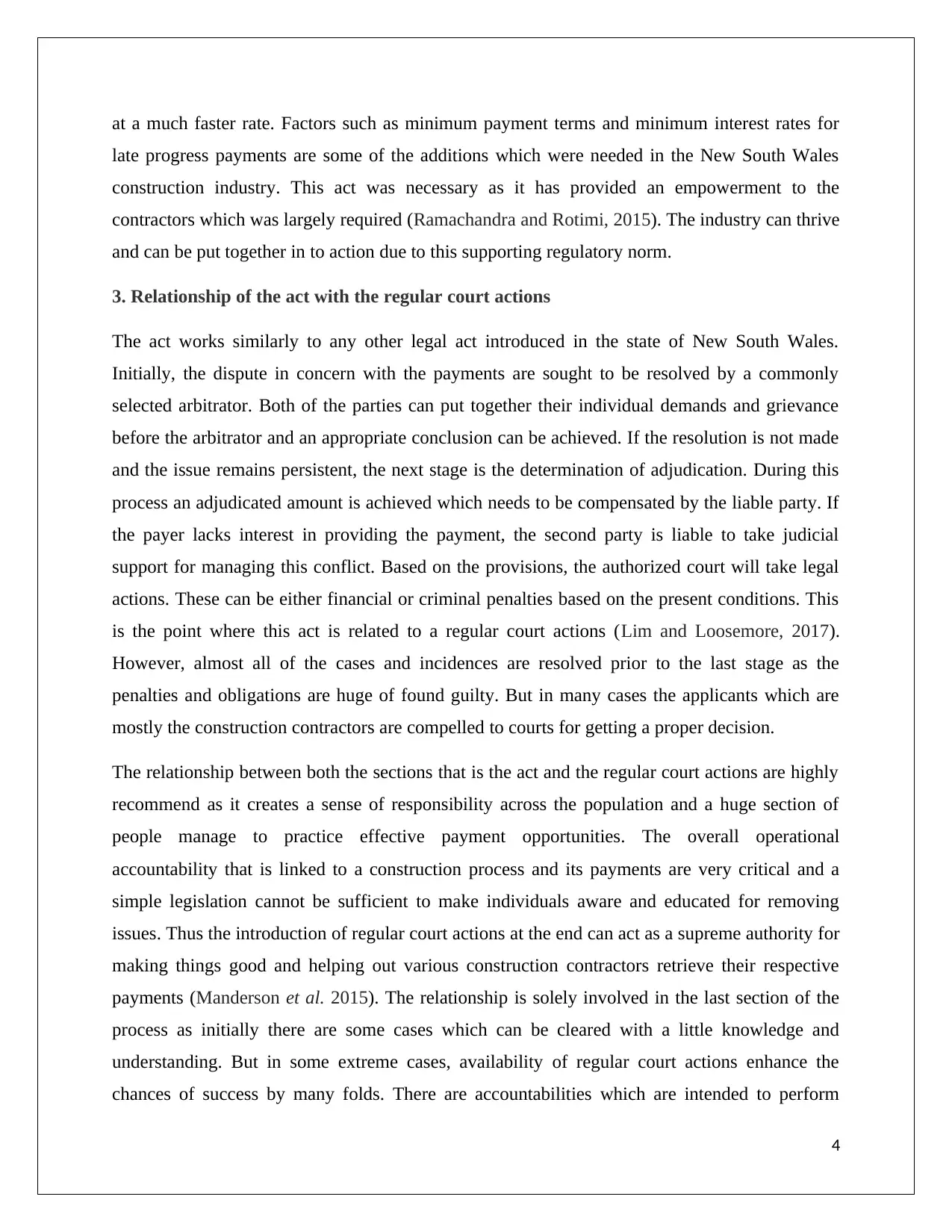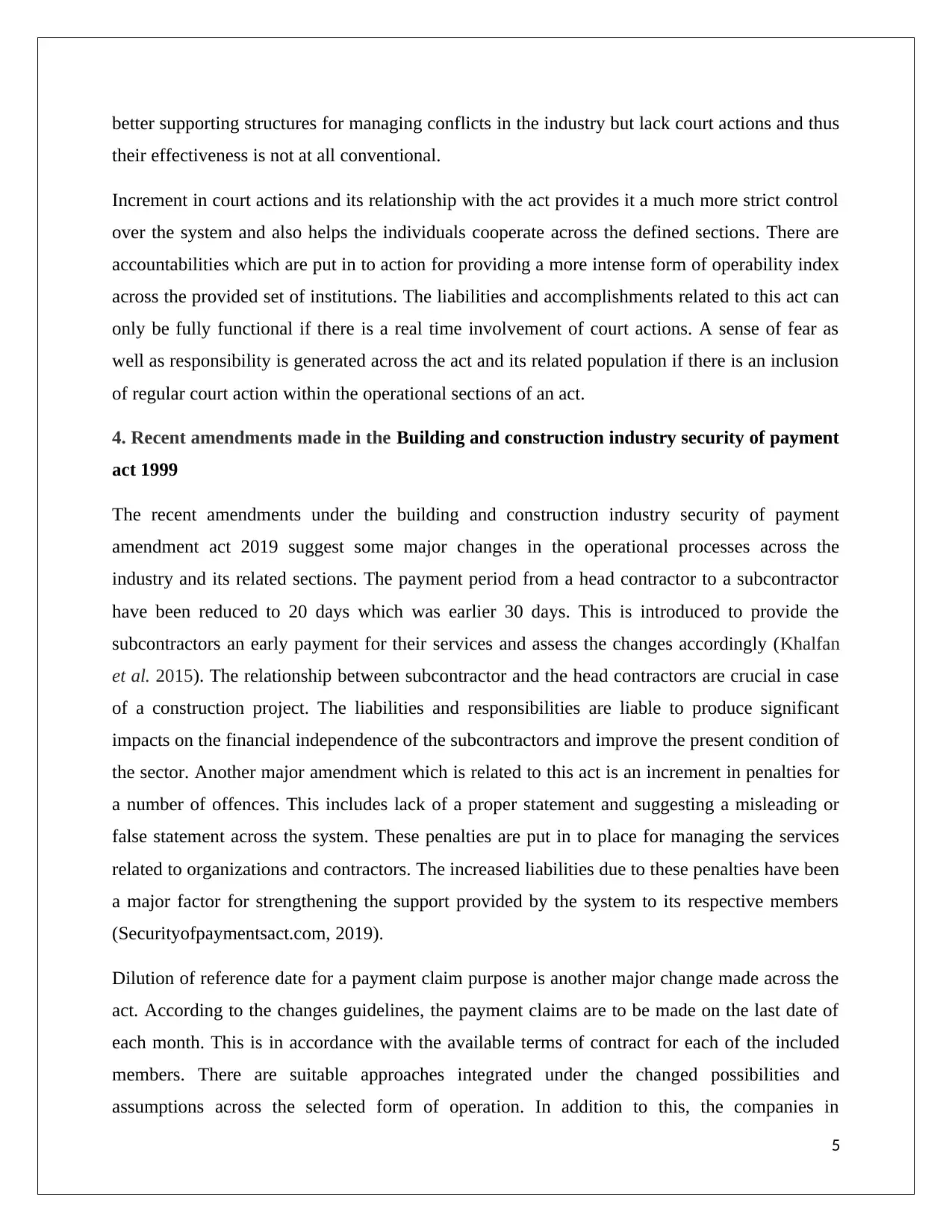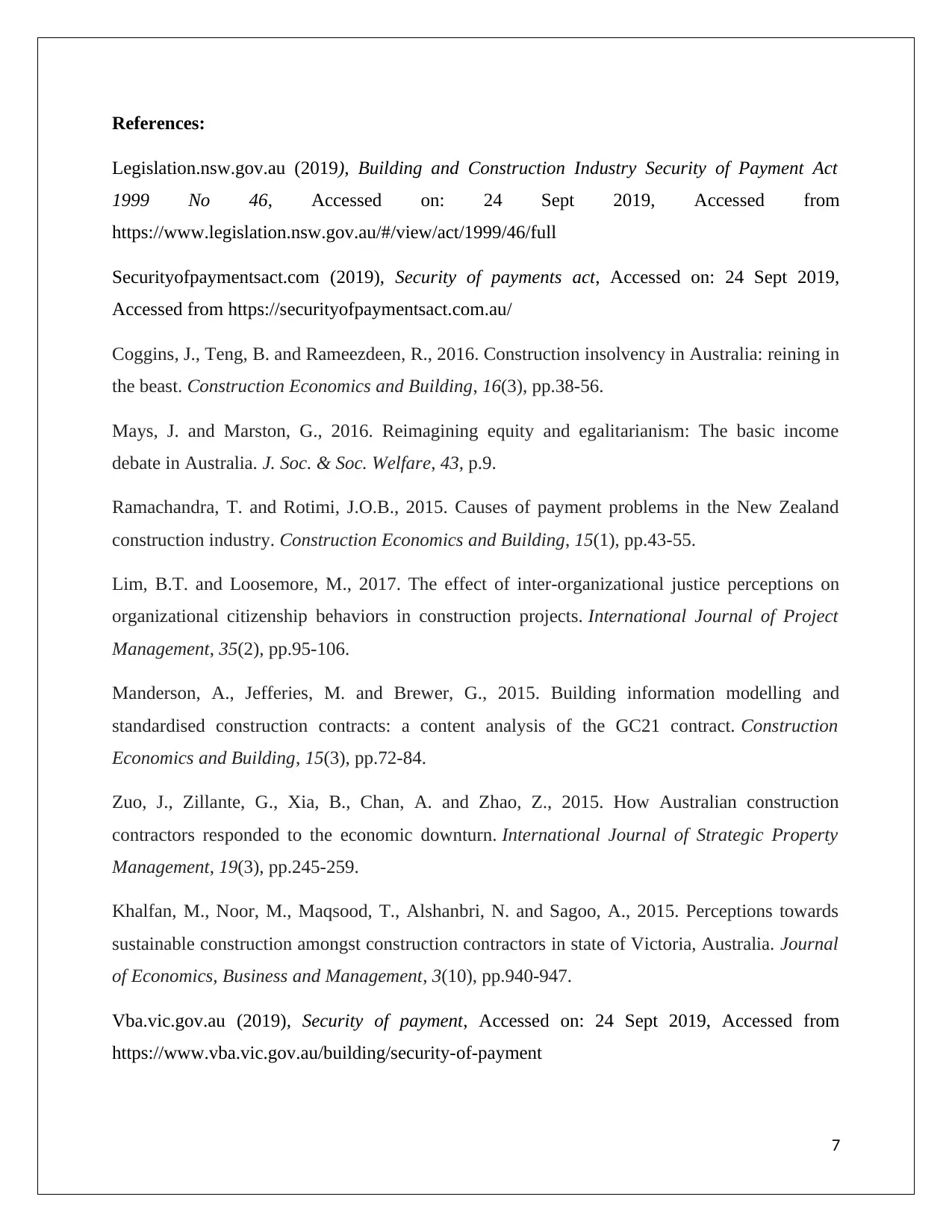LAW2309: Building and Construction Security of Payment Act Report
VerifiedAdded on 2022/10/13
|7
|2377
|64
Report
AI Summary
This report provides a detailed analysis of the Building and Construction Industry Security of Payment Act 1999, focusing on its role in regulating construction projects in New South Wales. The report examines the act's provisions for progress payments, dispute resolution, and the rights and obligations of various parties, including principals, head contractors, and subcontractors. It highlights the introduction of the act to address payment failures and protect contractors. The report also explores the relationship between the act and regular court actions, emphasizing the role of arbitrators and the potential for financial and criminal penalties in cases of breach. Furthermore, it discusses recent amendments to the act, such as the reduction in payment periods and the introduction of penalties for offenses, and how these changes aim to strengthen payment security and streamline operational processes. The analysis covers the act's overall impact on the construction industry, emphasizing its role in ensuring timely payments and promoting a more stable environment for contractors and subcontractors.

LAW23092019150
Secure Best Marks with AI Grader
Need help grading? Try our AI Grader for instant feedback on your assignments.

1. Working of the Building and construction industry security of payment act 1999
The Building and construction industry security of payment act 1999 is responsible for
regulating the New South Wales construction projects. All set of professionals related to the
construction industry are included under this act. This legal framework includes principals, head
contractors, suppliers and subordinates in context of making payments, withholding payments
and receiving payments. The law suggests that any individual who has been associated with a
construction work must receive progress payment as the work continuous. It also includes any
supply of goods which are related to the construction project. The scheme of progressive
payment is applicable for each of the belongings in a construction project and thus it cannot be
withheld (Coggins et al. 2016). The most suitable section of people who have been largely
benefited by this legal framework are the construction workers in New South Wales. In many
cases the courts were unable to proceed with adequate opportunities for making provisions for
partial payments in a construction project. But as this legal structure provides them with an
opportunity to make decisions concerning the workers and their right to get partial payments.
This act provides the contractors to get their progress payments in case of any available
contractual obligations such as written, verbal or absent contracts. However, the independent
contractor agreements in every case provides supportive information in concern with the
obligations and rights which must be provided to each of the related parties. This legal system
works independently and the calculation of progress payment is made based on the valuation of
work or commodity supplies which are made during a construction process. The contractual
terms play a major role in idealizing the growth pattern which is supported to functionalize
progress payments in each of the construction processes. The operational accountability for
service acceptors are mentioned under the specifically drafted contract which implies specific
terms and conditions which are entitled to produce significant impacts on the overall growth
possibility across the region. There are segments which signify the appropriate strategies and
accountabilities for measuring changes in these institutional obligations and thus the overall
acceptability factor is highly appreciated certainly (Legislation.nsw.gov.au, 2019).
The act incorporates separate provisions for related dispute resolutions. It provides possibility of
consultation from an independent arbitrator who can act as a resolution providing agent for each
of the involved parties. There are separate provisions for payment claims on accounts that how
2
The Building and construction industry security of payment act 1999 is responsible for
regulating the New South Wales construction projects. All set of professionals related to the
construction industry are included under this act. This legal framework includes principals, head
contractors, suppliers and subordinates in context of making payments, withholding payments
and receiving payments. The law suggests that any individual who has been associated with a
construction work must receive progress payment as the work continuous. It also includes any
supply of goods which are related to the construction project. The scheme of progressive
payment is applicable for each of the belongings in a construction project and thus it cannot be
withheld (Coggins et al. 2016). The most suitable section of people who have been largely
benefited by this legal framework are the construction workers in New South Wales. In many
cases the courts were unable to proceed with adequate opportunities for making provisions for
partial payments in a construction project. But as this legal structure provides them with an
opportunity to make decisions concerning the workers and their right to get partial payments.
This act provides the contractors to get their progress payments in case of any available
contractual obligations such as written, verbal or absent contracts. However, the independent
contractor agreements in every case provides supportive information in concern with the
obligations and rights which must be provided to each of the related parties. This legal system
works independently and the calculation of progress payment is made based on the valuation of
work or commodity supplies which are made during a construction process. The contractual
terms play a major role in idealizing the growth pattern which is supported to functionalize
progress payments in each of the construction processes. The operational accountability for
service acceptors are mentioned under the specifically drafted contract which implies specific
terms and conditions which are entitled to produce significant impacts on the overall growth
possibility across the region. There are segments which signify the appropriate strategies and
accountabilities for measuring changes in these institutional obligations and thus the overall
acceptability factor is highly appreciated certainly (Legislation.nsw.gov.au, 2019).
The act incorporates separate provisions for related dispute resolutions. It provides possibility of
consultation from an independent arbitrator who can act as a resolution providing agent for each
of the involved parties. There are separate provisions for payment claims on accounts that how
2

and in what circumstances it must be paid. The overall operability index which is related to a
principal, contractor and a subcontractor are different and this timeline must be maintained for
future operations. These obligations in terms of time and conditions of payment are set by the act
and remain same for each of the cases. In the case of breach, a series of financial as well as
criminal penalties are put in to place for the responsible parties (Mays and Marston, 2016). An
intentional breach of this act can lead to severe enforcement actions against the respective
sections. The strict possibility for penalty and enforcement actions are highly influential in order
to secure the rights and obligations of each section of the construction sector.
2. Introduction of the act
The Building and construction industry security of payment act 1999 or the security of payment
act was introduced with a sole intention to limit the losses faced by construction contractors due
to payment failures. The state and the country as well were facing acute issues in concern with
the lack in payment structure and its modifications. The losses were huge and many major
incidences of insolvency led to the deformation of this sector in a larger ways. The overall
operability factor which was put in to action soon after this legal framework was developed was
the lack in amount of insolvency for the construction industry organizations. This describes the
most certain need for this act. This act was introduced in an attempt to secure the rights and
obligations of the construction contractors. The incidences of payment failure were largely
increasing which were having a negative impact on the economic conditions across this industry,
thus a stiff operational model was necessary to cope with this unwanted issue. The basic idea
behind establishment of this act was to provide a protective atmosphere and some basic rights to
the available construction contractors. In addition to this, the act aimed to provide a secure way
to extract payments based on recovery progress payment systems (Vba.vic.gov.au, 2019).
The situation was unacceptable as the construction contractors were not able to get their partial
payments and this led to huge losses for their companies and ultimately fallout. The government
recognized this huge issue in late 2018 and put in context the act to secure progress payments for
each of the constructors. However, the other states in Australia have already been involved in
such operations, the New South Wales authorities will be putting it in to action on 21st October
2019. Since the act provides a series of enhancements to the contractors in terms of durable and
easy payment opportunities from their clients, the dying nature of this industry is liable to grow
3
principal, contractor and a subcontractor are different and this timeline must be maintained for
future operations. These obligations in terms of time and conditions of payment are set by the act
and remain same for each of the cases. In the case of breach, a series of financial as well as
criminal penalties are put in to place for the responsible parties (Mays and Marston, 2016). An
intentional breach of this act can lead to severe enforcement actions against the respective
sections. The strict possibility for penalty and enforcement actions are highly influential in order
to secure the rights and obligations of each section of the construction sector.
2. Introduction of the act
The Building and construction industry security of payment act 1999 or the security of payment
act was introduced with a sole intention to limit the losses faced by construction contractors due
to payment failures. The state and the country as well were facing acute issues in concern with
the lack in payment structure and its modifications. The losses were huge and many major
incidences of insolvency led to the deformation of this sector in a larger ways. The overall
operability factor which was put in to action soon after this legal framework was developed was
the lack in amount of insolvency for the construction industry organizations. This describes the
most certain need for this act. This act was introduced in an attempt to secure the rights and
obligations of the construction contractors. The incidences of payment failure were largely
increasing which were having a negative impact on the economic conditions across this industry,
thus a stiff operational model was necessary to cope with this unwanted issue. The basic idea
behind establishment of this act was to provide a protective atmosphere and some basic rights to
the available construction contractors. In addition to this, the act aimed to provide a secure way
to extract payments based on recovery progress payment systems (Vba.vic.gov.au, 2019).
The situation was unacceptable as the construction contractors were not able to get their partial
payments and this led to huge losses for their companies and ultimately fallout. The government
recognized this huge issue in late 2018 and put in context the act to secure progress payments for
each of the constructors. However, the other states in Australia have already been involved in
such operations, the New South Wales authorities will be putting it in to action on 21st October
2019. Since the act provides a series of enhancements to the contractors in terms of durable and
easy payment opportunities from their clients, the dying nature of this industry is liable to grow
3

at a much faster rate. Factors such as minimum payment terms and minimum interest rates for
late progress payments are some of the additions which were needed in the New South Wales
construction industry. This act was necessary as it has provided an empowerment to the
contractors which was largely required (Ramachandra and Rotimi, 2015). The industry can thrive
and can be put together in to action due to this supporting regulatory norm.
3. Relationship of the act with the regular court actions
The act works similarly to any other legal act introduced in the state of New South Wales.
Initially, the dispute in concern with the payments are sought to be resolved by a commonly
selected arbitrator. Both of the parties can put together their individual demands and grievance
before the arbitrator and an appropriate conclusion can be achieved. If the resolution is not made
and the issue remains persistent, the next stage is the determination of adjudication. During this
process an adjudicated amount is achieved which needs to be compensated by the liable party. If
the payer lacks interest in providing the payment, the second party is liable to take judicial
support for managing this conflict. Based on the provisions, the authorized court will take legal
actions. These can be either financial or criminal penalties based on the present conditions. This
is the point where this act is related to a regular court actions (Lim and Loosemore, 2017).
However, almost all of the cases and incidences are resolved prior to the last stage as the
penalties and obligations are huge of found guilty. But in many cases the applicants which are
mostly the construction contractors are compelled to courts for getting a proper decision.
The relationship between both the sections that is the act and the regular court actions are highly
recommend as it creates a sense of responsibility across the population and a huge section of
people manage to practice effective payment opportunities. The overall operational
accountability that is linked to a construction process and its payments are very critical and a
simple legislation cannot be sufficient to make individuals aware and educated for removing
issues. Thus the introduction of regular court actions at the end can act as a supreme authority for
making things good and helping out various construction contractors retrieve their respective
payments (Manderson et al. 2015). The relationship is solely involved in the last section of the
process as initially there are some cases which can be cleared with a little knowledge and
understanding. But in some extreme cases, availability of regular court actions enhance the
chances of success by many folds. There are accountabilities which are intended to perform
4
late progress payments are some of the additions which were needed in the New South Wales
construction industry. This act was necessary as it has provided an empowerment to the
contractors which was largely required (Ramachandra and Rotimi, 2015). The industry can thrive
and can be put together in to action due to this supporting regulatory norm.
3. Relationship of the act with the regular court actions
The act works similarly to any other legal act introduced in the state of New South Wales.
Initially, the dispute in concern with the payments are sought to be resolved by a commonly
selected arbitrator. Both of the parties can put together their individual demands and grievance
before the arbitrator and an appropriate conclusion can be achieved. If the resolution is not made
and the issue remains persistent, the next stage is the determination of adjudication. During this
process an adjudicated amount is achieved which needs to be compensated by the liable party. If
the payer lacks interest in providing the payment, the second party is liable to take judicial
support for managing this conflict. Based on the provisions, the authorized court will take legal
actions. These can be either financial or criminal penalties based on the present conditions. This
is the point where this act is related to a regular court actions (Lim and Loosemore, 2017).
However, almost all of the cases and incidences are resolved prior to the last stage as the
penalties and obligations are huge of found guilty. But in many cases the applicants which are
mostly the construction contractors are compelled to courts for getting a proper decision.
The relationship between both the sections that is the act and the regular court actions are highly
recommend as it creates a sense of responsibility across the population and a huge section of
people manage to practice effective payment opportunities. The overall operational
accountability that is linked to a construction process and its payments are very critical and a
simple legislation cannot be sufficient to make individuals aware and educated for removing
issues. Thus the introduction of regular court actions at the end can act as a supreme authority for
making things good and helping out various construction contractors retrieve their respective
payments (Manderson et al. 2015). The relationship is solely involved in the last section of the
process as initially there are some cases which can be cleared with a little knowledge and
understanding. But in some extreme cases, availability of regular court actions enhance the
chances of success by many folds. There are accountabilities which are intended to perform
4
Secure Best Marks with AI Grader
Need help grading? Try our AI Grader for instant feedback on your assignments.

better supporting structures for managing conflicts in the industry but lack court actions and thus
their effectiveness is not at all conventional.
Increment in court actions and its relationship with the act provides it a much more strict control
over the system and also helps the individuals cooperate across the defined sections. There are
accountabilities which are put in to action for providing a more intense form of operability index
across the provided set of institutions. The liabilities and accomplishments related to this act can
only be fully functional if there is a real time involvement of court actions. A sense of fear as
well as responsibility is generated across the act and its related population if there is an inclusion
of regular court action within the operational sections of an act.
4. Recent amendments made in the Building and construction industry security of payment
act 1999
The recent amendments under the building and construction industry security of payment
amendment act 2019 suggest some major changes in the operational processes across the
industry and its related sections. The payment period from a head contractor to a subcontractor
have been reduced to 20 days which was earlier 30 days. This is introduced to provide the
subcontractors an early payment for their services and assess the changes accordingly (Khalfan
et al. 2015). The relationship between subcontractor and the head contractors are crucial in case
of a construction project. The liabilities and responsibilities are liable to produce significant
impacts on the financial independence of the subcontractors and improve the present condition of
the sector. Another major amendment which is related to this act is an increment in penalties for
a number of offences. This includes lack of a proper statement and suggesting a misleading or
false statement across the system. These penalties are put in to place for managing the services
related to organizations and contractors. The increased liabilities due to these penalties have been
a major factor for strengthening the support provided by the system to its respective members
(Securityofpaymentsact.com, 2019).
Dilution of reference date for a payment claim purpose is another major change made across the
act. According to the changes guidelines, the payment claims are to be made on the last date of
each month. This is in accordance with the available terms of contract for each of the included
members. There are suitable approaches integrated under the changed possibilities and
assumptions across the selected form of operation. In addition to this, the companies in
5
their effectiveness is not at all conventional.
Increment in court actions and its relationship with the act provides it a much more strict control
over the system and also helps the individuals cooperate across the defined sections. There are
accountabilities which are put in to action for providing a more intense form of operability index
across the provided set of institutions. The liabilities and accomplishments related to this act can
only be fully functional if there is a real time involvement of court actions. A sense of fear as
well as responsibility is generated across the act and its related population if there is an inclusion
of regular court action within the operational sections of an act.
4. Recent amendments made in the Building and construction industry security of payment
act 1999
The recent amendments under the building and construction industry security of payment
amendment act 2019 suggest some major changes in the operational processes across the
industry and its related sections. The payment period from a head contractor to a subcontractor
have been reduced to 20 days which was earlier 30 days. This is introduced to provide the
subcontractors an early payment for their services and assess the changes accordingly (Khalfan
et al. 2015). The relationship between subcontractor and the head contractors are crucial in case
of a construction project. The liabilities and responsibilities are liable to produce significant
impacts on the financial independence of the subcontractors and improve the present condition of
the sector. Another major amendment which is related to this act is an increment in penalties for
a number of offences. This includes lack of a proper statement and suggesting a misleading or
false statement across the system. These penalties are put in to place for managing the services
related to organizations and contractors. The increased liabilities due to these penalties have been
a major factor for strengthening the support provided by the system to its respective members
(Securityofpaymentsact.com, 2019).
Dilution of reference date for a payment claim purpose is another major change made across the
act. According to the changes guidelines, the payment claims are to be made on the last date of
each month. This is in accordance with the available terms of contract for each of the included
members. There are suitable approaches integrated under the changed possibilities and
assumptions across the selected form of operation. In addition to this, the companies in
5

liquidation are restricted for SOP Acts and are not liable to make any payment enforcement and
claim. The dates for termination can also act as the date for payment if the termination takes
place. This is to ensure that there is a significant impact on the operational accountability across
the defined sections and a more suitable set of applications are liable to produce throughout the
system and scenario. These changes have been put in to place with an ideology of maintaining
varied support to the industry and its related dimensions and provide them with a more organized
form of situation (Zuo et al. 2015). The amendments were also in accordance with disputed
claims and their exclusion from the available set of regulatory provision. There was a provision
for making payment claims after the termination has been provided. This particular clause have
been omitted in this amendment in order to strengthen the system and eliminate irregularities and
disruptions.
6
claim. The dates for termination can also act as the date for payment if the termination takes
place. This is to ensure that there is a significant impact on the operational accountability across
the defined sections and a more suitable set of applications are liable to produce throughout the
system and scenario. These changes have been put in to place with an ideology of maintaining
varied support to the industry and its related dimensions and provide them with a more organized
form of situation (Zuo et al. 2015). The amendments were also in accordance with disputed
claims and their exclusion from the available set of regulatory provision. There was a provision
for making payment claims after the termination has been provided. This particular clause have
been omitted in this amendment in order to strengthen the system and eliminate irregularities and
disruptions.
6

References:
Legislation.nsw.gov.au (2019), Building and Construction Industry Security of Payment Act
1999 No 46, Accessed on: 24 Sept 2019, Accessed from
https://www.legislation.nsw.gov.au/#/view/act/1999/46/full
Securityofpaymentsact.com (2019), Security of payments act, Accessed on: 24 Sept 2019,
Accessed from https://securityofpaymentsact.com.au/
Coggins, J., Teng, B. and Rameezdeen, R., 2016. Construction insolvency in Australia: reining in
the beast. Construction Economics and Building, 16(3), pp.38-56.
Mays, J. and Marston, G., 2016. Reimagining equity and egalitarianism: The basic income
debate in Australia. J. Soc. & Soc. Welfare, 43, p.9.
Ramachandra, T. and Rotimi, J.O.B., 2015. Causes of payment problems in the New Zealand
construction industry. Construction Economics and Building, 15(1), pp.43-55.
Lim, B.T. and Loosemore, M., 2017. The effect of inter-organizational justice perceptions on
organizational citizenship behaviors in construction projects. International Journal of Project
Management, 35(2), pp.95-106.
Manderson, A., Jefferies, M. and Brewer, G., 2015. Building information modelling and
standardised construction contracts: a content analysis of the GC21 contract. Construction
Economics and Building, 15(3), pp.72-84.
Zuo, J., Zillante, G., Xia, B., Chan, A. and Zhao, Z., 2015. How Australian construction
contractors responded to the economic downturn. International Journal of Strategic Property
Management, 19(3), pp.245-259.
Khalfan, M., Noor, M., Maqsood, T., Alshanbri, N. and Sagoo, A., 2015. Perceptions towards
sustainable construction amongst construction contractors in state of Victoria, Australia. Journal
of Economics, Business and Management, 3(10), pp.940-947.
Vba.vic.gov.au (2019), Security of payment, Accessed on: 24 Sept 2019, Accessed from
https://www.vba.vic.gov.au/building/security-of-payment
7
Legislation.nsw.gov.au (2019), Building and Construction Industry Security of Payment Act
1999 No 46, Accessed on: 24 Sept 2019, Accessed from
https://www.legislation.nsw.gov.au/#/view/act/1999/46/full
Securityofpaymentsact.com (2019), Security of payments act, Accessed on: 24 Sept 2019,
Accessed from https://securityofpaymentsact.com.au/
Coggins, J., Teng, B. and Rameezdeen, R., 2016. Construction insolvency in Australia: reining in
the beast. Construction Economics and Building, 16(3), pp.38-56.
Mays, J. and Marston, G., 2016. Reimagining equity and egalitarianism: The basic income
debate in Australia. J. Soc. & Soc. Welfare, 43, p.9.
Ramachandra, T. and Rotimi, J.O.B., 2015. Causes of payment problems in the New Zealand
construction industry. Construction Economics and Building, 15(1), pp.43-55.
Lim, B.T. and Loosemore, M., 2017. The effect of inter-organizational justice perceptions on
organizational citizenship behaviors in construction projects. International Journal of Project
Management, 35(2), pp.95-106.
Manderson, A., Jefferies, M. and Brewer, G., 2015. Building information modelling and
standardised construction contracts: a content analysis of the GC21 contract. Construction
Economics and Building, 15(3), pp.72-84.
Zuo, J., Zillante, G., Xia, B., Chan, A. and Zhao, Z., 2015. How Australian construction
contractors responded to the economic downturn. International Journal of Strategic Property
Management, 19(3), pp.245-259.
Khalfan, M., Noor, M., Maqsood, T., Alshanbri, N. and Sagoo, A., 2015. Perceptions towards
sustainable construction amongst construction contractors in state of Victoria, Australia. Journal
of Economics, Business and Management, 3(10), pp.940-947.
Vba.vic.gov.au (2019), Security of payment, Accessed on: 24 Sept 2019, Accessed from
https://www.vba.vic.gov.au/building/security-of-payment
7
1 out of 7
Related Documents
Your All-in-One AI-Powered Toolkit for Academic Success.
+13062052269
info@desklib.com
Available 24*7 on WhatsApp / Email
![[object Object]](/_next/static/media/star-bottom.7253800d.svg)
Unlock your academic potential
© 2024 | Zucol Services PVT LTD | All rights reserved.





